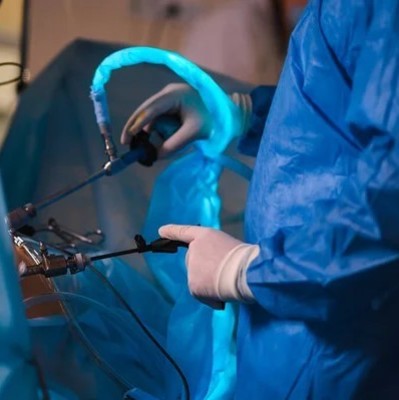Hernia Surgery

Please click the questions below to reveal the answer
A hernia occurs when an internal part of the body protrudes through a weakness in the wall of its containing cavity. It appears as an abnormal protrusion or lump usually found in the groin or abdominal wall. The lump can often be pushed back in, or disappears when you lie down. Coughing may make the lump reappear.
Types of hernias include:
Inguinal hernia – A common groin hernia, which often causes a dragging pain, made worse by activity. 25% of males and 2% of females will develop an inguinal hernia in their lifetime
Umbilical hernia – A hernia that protrudes at the belly button
Epigastric Hernia – A hernia that protrudes in the midline between the belly button and bottom of the rib cage
Hiatal Hernia – A herniation of the stomach up into the chest, which often causes symptoms of reflux.
Incisional Hernia – A hernia protruding through a weakness in a previous operation site
Hernias occur due to a weakness in the investing muscle wall of the abdominal cavity. The weakness eventually gives way and allows internal parts to protrude out. Raised intra-abdominal pressure leads to the rupture at the site of the weakness. Common sites of weakness in the abdominal wall include the inguinal canal and umbilicus. Causes for raised intra-abdominal pressure include obesity, lifting heavy objects, chronic cough and straining due to constipation. Poor nutrition, smoking, and overexertion can weaken muscles and contribute to the likelihood of a hernia.
Hernias can cause discomfort or pain, often made worse by activity. Groin hernias in particular can lead to a dragging sensation, which is often worse after long periods of standing or exercise. If bowel becomes stuck in the hernia sac, there is a chance that it may become obstructed/strangulated leading to severe abdominal pain and vomiting.
Small hernias can be asymptomatic but will likely cause symptoms as they enlarge. Two thirds of inguinal hernias will crossover in a period of ten years.
Strangulation or obstruction of bowel are the main risk of hernias. Strangulation is where a bowel loop becomes caught in a hernia sac and loses its blood supply on twisting. It eventually becomes gangrenous and requires an emergency operation for repair. Fortunately, this is not common, occurring in less than 5% of patients with inguinal hernias per year.
Hernias do not get better on their own.
The majority of hernias can be diagnosed with a clinical examination by a specialist, however on occasion a specialist may request an ultrasound or CT scan to confirm the diagnosis.
There are many causes for groin/abdominal pain. Your symptoms are best assessed by a specialist surgeon.
Hernias can be treated with an operation or watchful waiting.
With an operation, the hernia defect is repaired and often reinforced with mesh to reduce the risk of recurrence. Most people will go home on the same or the day after the operation. Types of operation include:
Keyhole (Laparoscopic) Hernia Repair– The surgeon makes several sub-cm incisions on the abdomen to allow surgical tools into the opening to perform a minimally invasive operation under General Anaesthetic.
Open Hernia Repair – The surgeon makes an incision near the hernia and repairs the rupture under General Anaesthetic
There is good evidence that keyhole repair reduces the time of post-operative recovery.
Some hernias, in particular those that are small and asymptomatic, can be managed without surgery. The need for surgery can be assessed by a specialist surgeon who can advise you appropriately.
The most common type of abdominal wall hernia after pregnancy is an umbilical hernia. The repair will not affect fertility, however the timing of the repair is crucial to reduce the chance of hernia recurrence. This will be based on chances of future pregnancies, the risks of strangulation and symptoms.
Inguinal hernia repair in men has not been shown to have an effect of long-term fertility unless the Vas Deferens (the tube that carries sperm) is inadvertently damaged during the operation. The risk of this is approximately 0.3%.
The use of mesh significantly reduces the risk of hernia recurrence in comparison to suture repair techniques.
In a Danish study of 13,674 primary inguinal hernia repairs (Bisgaard, et al) with an observation interval of 5 years or more, the risk of reoperation after mesh repair due to recurrence was a quarter of that after sutured repair. After 5 years, the reoperation rate increased continuously after sutured repair but not after mesh repair.
The implantation of meshes has been shown to significantly decreases the overall recurrence rate, the occurrence of chronic pain and the time of return to normal activity, as compared to non-mesh techniques.
There are case reports in the literature of mesh erosion into the bladder, vas deferens and bowel but these are extremely rare occurrences.
For many patients, surgical mesh reduces the actual time required in surgery and helps decrease post-surgery recovery time.
Hernia repair is a common and safe operation, however specific risks include:
Hernia recurrence (2%) - This risk is significantly increased if the repair is performed without mesh.
Wound infection (2%) – This is usually superficial and can be treated with antibiotics. Rarely the mesh may become infected, requiring removal (0.1%).
Bruising, haematoma and seroma (5%) - Seromas and haematomas are due to the collection of fluid or blood in the dead space that remains once a hernia sac has been reduced. It can present as significant swelling. They usually resolve of their own accord.
Chronic pain (4-10%) – This is pain at the repair site lasting for more than 3 months. In 1/3 of cases the pain resolves in 6 months. The pain may be caused by nerve entrapment or scar tissue.
Injury to testicular blood supply (0.3%) - Interference of the blood supply may cause testicular pain, shrinkage or swelling.
Injury to Vas Deferens (0.3%)
Urinary Retention (1-3%) - It is usually happens in elderly patients, especially if symptoms of prostatism are present.
Daily activity – Mobilise as soon as possible after surgery and try to keep active. Avoid lifting anything over 10kg for the first six weeks
Washing – You are free to shower any time after the operation as you will have a waterproof glue dressing on the skin. The glue can be peeled off on day 7. Avoid bathing, jacuzzi or swimming for the first 2 weeks after the operation.
Work – Manual Jobs requiring heavy lifting should be avoided for the first 6 weeks after surgery.
Driving – Always check with your individual insurance company but most would advise abstaining for 1 to 2 weeks depending on whether you have stopped any strong pain killers such as codeine and or can do an emergency stop without pain.
Exercise – safe to return to cardiovascular exercise at 4 weeks and lifting weights with caution at 6 weeks
Sex – safe to return to normal at two weeks to avoid wound infection.






